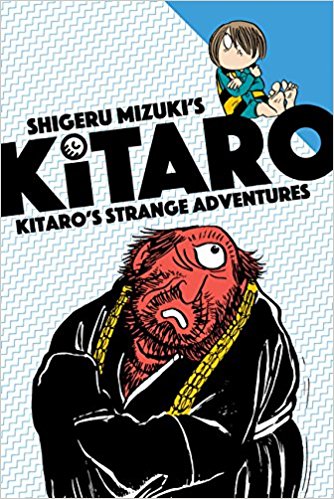By Shigeru Mizuki. Released in Japan as “Gegege no Kitaro” by Kodansha and Shogakukan, serialized in various magazines. Released in North America by Drawn & Quarterly. Translated by Zack Davisson.
As the title might suggest, there’s no really big epic in this volume of Kitaro. We get two medium sized adventures and some shorter stories, all of which are decent and show off the strengths of the Kitaro manga and characters. Kitaro not only battles against Chinese yokai who are trying to invade, but also demons from hell. And here we see that Kitaro and his world are something for children – they’re the ones who see and interact with Kitaro, and they’re the ones who are endangered. Occasionally we see an adult with issues, such as the man who has a cursed hand, but mostly in terms of yokai Kitaro is something that adults don’t believe in anymore, but kids know is real. It’s a good way to get the reader on your side, and Mizuki is a master at it.
Though we do see several recurring yokai, this is not the cozy Kitoaro of the 1990s (Neko Musume is mentioned in the accompanying history but nowhere in sight), and there’s honestly only three who are of any importance here: Kitaro, his eyeball father, and the amazingly two-faced Nezumi Otoko, who continues to show off why he became the breakout favorite character of this series. He’s such an appalling ass, showing off that he’ll do anything for money, will say anything to save his own skin, and that he gives up super easily and accepts a horrible fate – he seems to literally have no positive traits whatsover. Except, of course, that he makes the reader laugh. (Kudos to Zack Davisson’s translation here, by the way, which excels at making Nezumi Otoko funny – I lost it at “I’m just a carefree college student!”.)
I will say that it’s very clear that these are being written on the fly, and that Mizuki puts down all the ideas he has on the page, and when he runs out of them the story stops – sometimes quite abruptly. None of these are week-to-week serials with cliffhangers, they’re all self-contained. Sometimes the climaxes are epic, such as the final battle against the Chinese yokai, which is essentially two armies going after one another. And sometimes the need to wrap up a story in order to meet the page count is so obvious it becomes hilarious, and you get moments like “Kitaro fires his machine gun teeth and hits the monster in the nuts”, which is, let’s face it, something that you are highly unlikely to see in most modern manga. Though I think One Piece might give it a shot.
This is another solid volume of Kitaro, and I’m delighted to see the anthology coming out over here, containing stories approved by Mizuki before his death. And while all the stories are about yokai you never quite know what you’re going to get next – I understand the next volume crosses over with Buffy and the Beatles! OK, probably not. But it’s definitely going to be a must read. These are good editions of classic influential manga.





